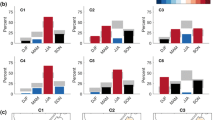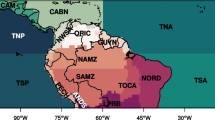Abstract
The cause-effect relationship between meso-γ-scale rotation and extreme short-term precipitation events remains elusive in mesoscale meteorological research. We aimed to elucidate this relationship by analyzing a rainstorm over the Pearl River Delta during the nocturnal hours of 15 May 2017 based on 6-min radar observations and 1-min rain gauge data. This rainstorm had a maximum hourly rainfall of 100.1 mm, with 26 stations recording hourly rainfall > 60 mm h.1 in 5 h. Extreme heavy precipitation was produced in association with a convergence zone along the southern side of a synoptic low-level shear line, where southwesterly warm, humid airflows with precipitable water of > 60 mm, little convection inhibition (< 10 J kg-1), and a low lifting condensation level (about 300 m) dominated. A meso-γ-scale vortex was quantitatively identified during the hour with the largest number of gauges observing extreme hourly rainfall. The vortex had a mean diameter of 6.1 km and a peak intensity of 3.1 × 10-3 s-1 during its lifetime of 54 min. The vortex initialized and remained inside the region of extreme rain rates (radar-retrieved rain rates > 100 mm h-1), reached its peak intensity after the peak of the collocated 6-min rainfall accumulation, and then weakened rapidly after the extreme rainfall region moved away. The radar-retrieved liquid water path was about five to seven times the ice water path and the specific differential phase (Kdp) below 0°C increased sharply downward during the lifetime of the vortex, suggesting the presence of active warm rain microphysical processes. These results indicate that the release of the latent heat of condensation induced by extreme rainfall could have contributed to the formation of the vortex in an environment with a weak 0.1-km vertical wind shear (about 4–5 m s-1) through enhanced lowlevel convergence, although the strengthening of low-level updrafts by rotational dynamic effects and short-term rainfall cannot be ruled out.
Similar content being viewed by others
References
Bao, C. L., 1986: Research progresses of heavy rainfall over South China in pre-summer rainy season. Acta Oceanol. Sinica, 8, 31–40. (in Chinese)
Bao, X. H., Y. L. Luo, and X. Y. Gao, 2021: The synoptic impacts on the convection initiation of a warm-sector heavy rainfall event over coastal South China prior to the monsoon onset: A numerical modeling study. J. Geophys. Res. Atmos., 126, e2020JD034335, doi: https://doi.org/10.1029/2020JD034335.
Brewster, K., M. Hu, M. Xue, et al., 2005: Efficient assimilation of radar data at high resolution for short-range numerical weather prediction. 3.06. Available online at http://twister.ou.edu/papers/BrewsterWWRP_Nowcasting.pdf. Accessed on 27 July 2022.
Carey, L. D., and S. A. Rutledge, 2000: The relationship between precipitation and lightning in tropical island convection: A Cband polarimetric radar study. Mon. Wea. Rev., 128, 2687–2710, doi: https://doi.org/10.1175/1520-0493(2000)128<2687:TRBPAL>2.0.CO;2.
Changnon, S. A., Jr., 1968: The La Porte weather anomaly-fact or fiction? Bull. Amer. Meteor. Soc., 49, 4–11, doi: https://doi.org/10.1175/1520-0477-49.1.4.
Chen, Y. R. X., and Y. L. Luo, 2018: Analysis of paths and sources of moisture for the South China rainfall during the presummer rainy season of 1979-2014. J. Meteor. Res., 32, 744–757, doi: https://doi.org/10.1007/s13351-018-8069-7.
Cifelli, R., W. A. Petersen, L. D. Carey, et al., 2002: Radar observations of the kinematic, microphysical, and precipitation characteristics of two MCSs in TRMM LBA. J. Geophys. Res. Atmos., 107, 8077, doi: https://doi.org/10.1029/2000JD000264.
Cocks, S. B., L. Tang, P. F. Zhang, et al., 2019: A prototype quantitative precipitation estimation algorithm for operational Sband polarimetric radar utilizing specific attenuation and specific differential phase. Part II: Performance verification and case study analysis. J. Hydrometeor., 20, 999–1014, doi: https://doi.org/10.1175/JHM-D-18-0070.1.
Davis, C., N. Atkins, D. Bartels, et al., 2004: The bow echo and MCV experiment: Observations and opportunities. Bull. Amer. Meteor. Soc., 85, 1075–1094, doi: https://doi.org/10.1175/BAMS-85-8-1075.
Davis, J. M., and M. D. Parker, 2014: Radar climatology of tornadic and nontornadic vortices in high-shear, low-CAPE environments in the mid-Atlantic and southeastern United States. Wea. Forecasting, 29, 828–853, doi: https://doi.org/10.1175/WAF-D-13-00127.1.
Ding, Y. H., 1994: Monsoons over China. Kluwer Academic Publishers, Boston, 419 pp.
Du, Y., and G. X. Chen, 2019: Heavy rainfall associated with double low-level jets over southern China. Part II: Convection initiation. Mon. Wea. Rev., 147, 543–565, doi: https://doi.org/10.1175/MWR-D-18-0102.1.
Gao, X. Y., Y. L. Luo, Y. L. Lin, et al., 2022: A source of WRF simulation error for the early-summer warm-sector heavy rainfall over South China coast: Land-sea thermal contrast in the boundary layer. J. Geophys. Res. Atmos., 127, e2021JD 035179, doi: https://doi.org/10.1029/2021JD035179.
Huang, S. S., Z. G. Li, C. L. Bao, et al., 1986: Heavy Rainfall over Southern China in the Pre-Summer Rainy Season. Guangdong Science and Technology Press, Guangzhou, 244 pp. (in Chinese)
Johnson, J. T., P. L. MacKeen, A. Witt, et al., 1998: The storm cell identification and tracking algorithm: An enhanced WSR-88D algorithm. Wea. Forecasting, 13, 263–276, doi: https://doi.org/10.1175/1520-0434(1998)013<0263:TSCIAT>2.0.CO;2.
Li, H. Q., Q. L. Wan, D. D. Peng, et al., 2020: Multiscale analysis of a record-breaking heavy rainfall event in Guangdong, China. Atmos. Res., 232, 104703, doi: https://doi.org/10.1016/j.atmosres.2019.104703.
Li, M. X., Y. L. Luo, D.-L. Zhang, et al., 2021: Analysis of a record- breaking rainfall event associated with a monsoon coastal megacity of South China using multisource data. IEEE Trans. Geosci. Remote Sens., 59, 6404–6414, doi: https://doi.org/10.1109/tgrs.2020.3029831.
Liu, C. T., and E. J. Zipser, 2015: The global distribution of largest, deepest, and most intense precipitation systems. Geophys. Res. Lett., 42, 3591–3595, doi: https://doi.org/10.1002/2015GL063776.
Luo, Y. L., M. W. Wu, F. M. Ren, et al., 2016: Synoptic situations of extreme hourly precipitation over China. J. Climate, 29, 8703–8719, doi: https://doi.org/10.1175/JCLI-D-16-0057.1.
Luo, Y. L., R. H. Zhang, Q. L. Wan, et al., 2017: The Southern China Monsoon Rainfall Experiment (SCMREX). Bull. Amer. Meteor. Soc., 98, 999–1013, doi: https://doi.org/10.1175/BAMS-D-15-00235.1.
Luo, Y. L., R. D. Xia, and J. C. L. Chan, 2020: Characteristics, physical mechanisms, and prediction of pre-summer rainfall over South China: Research progress during 2008-2019. J. Meteor. Soc. Japan, 98, 19–42, doi: https://doi.org/10.2151/jmsj.2020-002.
Markowski, P., and Y. Richardson, 2010: Mesoscale Meteorology in Midlatitudes. John Wiley & Sons, Ltd., Chichester, 430 pp.
Morales, A., R. S. Schumacher, and S. M. Kreidenweis, 2015: Mesoscale vortex development during extreme precipitation: Colorado, September 2013. Mon. Wea. Rev., 143, 4943–4962, doi: https://doi.org/10.1175/MWR-D-15-0086.1.
Newman, J. F., V. Lakshmanan, P. L. Heinselman, et al., 2013: Range-correcting azimuthal shear in Doppler radar data. Wea. Forecasting, 28, 194–211, doi: https://doi.org/10.1175/WAF-D-11-00154.1.
Nielsen, E. R., and R. S. Schumacher, 2018: Dynamical insights into extreme short-term precipitation associated with supercells and mesovortices. J. Atmos. Sci., 75, 2983–3009, doi: https://doi.org/10.1175/JAS-D-17-0385.1.
Nielsen, E. R., and R. S. Schumacher, 2020a: Dynamical mechanisms supporting extreme rainfall accumulations in the Houston “Tax Day” 2016 flood. Mon. Wea. Rev., 148, 83–109, doi: https://doi.org/10.1175/MWR-D-19-0206.1.
Nielsen, E. R., and R. S. Schumacher, 2020b: Observations of extreme short-term precipitation associated with supercells and mesovortices. Mon. Wea. Rev., 148, 159–182, doi: https://doi.org/10.1175/MWR-D-19-0146.1.
Ramage, C. S., 1952: Variation of rainfall over South China through the wet season. Bull. Amer. Meteor. Soc., 33, 308–311, doi: https://doi.org/10.1175/1520-0477-33.7.308.
Raymond, D. J., and H. Jiang, 1990: A theory for long-lived mesoscale convective systems. J. Atmos. Sci., 47, 3067–3077, doi: https://doi.org/10.1175/1520-0469(1990)047<3067:ATFLLM>2.0.CO;2.
Seo, B.-C., W. F. Krajewski, and A. Ryzhkov, 2020: Evaluation of the specific attenuation method for radar-based quantitative precipitation estimation: Improvements and practical challenges. J. Hydrometeor., 21, 1333–1347, doi: https://doi.org/10.1175/JHMD-20-0030.1.
Shepherd, J. M., 2005: A review of current investigations of urban-induced rainfall and recommendations for the future. Earth Interact., 9, 1–27, doi: https://doi.org/10.1175/EI156.1.
Smith, T. M., and K. L. Elmore, 2004: The use of radial velocity derivative to diagnose rotation and divergence. 11th Conf. on Aviation, Range, and Aerospace, Hyannis, MA, Amer. Meteor. Soc., P5.6. Available online at http://ams.confex.com/ams/pdfpapers/81827.pdf. Accessed on 28 July 2022.
Sun, J. Z., and N. A. Crook, 1997: Dynamical and microphysical retrieval from Doppler radar observations using a cloud model and its adjoint. Part I: Model development and simulated data experiments. J. Atmos. Sci., 54, 1642–1661, doi: https://doi.org/10.1175/1520-0469(1997)054<1642:DAMRFD>2.0.CO;2.
Sun, X. Y., Y. L. Luo, X. Y. Gao, et al., 2021: On the localized extreme rainfall over the Great Bay Area in South China with complex topography and strong UHI effects. Mon. Wea. Rev., 149, 2777–2801, doi: https://doi.org/10.1175/MWR-D-21-0004.1.
Tang, Y., X. Xu, M. Xue, et al., 2020: Characteristics of low-level meso-γ-scale vortices in the warm season over East China. Atmos. Res., 235, 104768, doi: https://doi.org/10.1016/j.atmosres.2019.104768.
Trapp, R. J., and M. L. Weisman, 2003: Low-level mesovortices within squall lines and bow echoes. Part II: Their genesis and implications. Mon. Wea. Rev., 131, 2804–2823, doi: https://doi.org/10.1175/1520-0493(2003)131<2804:LMWSLA>2.0.CO;2.
Wang, G. L., D.-L. Zhang, and J. S. Sun, 2021: A multiscale analysis of a nocturnal extreme rainfall event of 14 July 2017 in Northeast China. Mon. Wea. Rev., 149, 173–187, doi: https://doi.org/10.1175/MWR-D-20-0232.1.
Wang, H., Y. L. Luo, and B. J.-D. Jou, 2014: Initiation, maintenance, and properties of convection in an extreme rainfall event during SCMREX: Observational analysis. J. Geophys. Res. Atmos., 119, 13,206–13,232, doi: https://doi.org/10.1002/2014JD022339.
Wang, Y. D., S. Cocks, L. Tang, et al., 2019: A prototype quantitative precipitation estimation algorithm for operational Sband polarimetric radar utilizing specific attenuation and specific differential phase. Part I: Algorithm description. J. Hydrometeor., 20, 985–997, doi: https://doi.org/10.1175/JHM-D-18-0071.1.
Weisman, M. L., and R. J. Trapp, 2003: Low-level mesovortices within squall lines and bow echoes. Part I: Overview and dependence on environmental shear. Mon. Wea. Rev., 131, 2779–2803, doi: https://doi.org/10.1175/1520-0493(2003)131<2779:LMWSLA>2.0.CO;2.
Wu, M. W., and Y. L. Luo, 2016: Mesoscale observational analysis of lifting mechanism of a warm-sector convective system producing the maximal daily precipitation in China mainland during pre-summer rainy season of 2015. J. Meteor. Res., 30, 719–736, doi: https://doi.org/10.1007/s13351-016-6089-8.
Wu, M. W., Y. L. Luo, F. Chen, et al., 2019: Observed link of extreme hourly precipitation changes to urbanization over coastal South China. J. Appl. Meteor. Climatol., 58, 1799–1819, doi: https://doi.org/10.1175/JAMC-D-18-0284.1.
Xue, M., K. K. Droegemeier, and V. Wong, 2000: The Advanced Regional Prediction System (ARPS)-A multi-scale nonhydrostatic atmospheric simulation and prediction model. Part I: Model dynamics and verification. Meteor. Atmos. Phys., 75, 161–193, doi: https://doi.org/10.1007/s007030070003.
Yao, X. P., J. L. Ma, D.-L. Zhang, et al., 2020: A 33-yr mei-yuseason climatology of shear lines over the Yangtze-Huai River basin in eastern China. J. Appl. Meteor. Climatol., 59, 1125–1137, doi: https://doi.org/10.1175/JAMC-D-19-0229.1.
Yin, J. F., D.-L. Zhang, Y. L. Luo, et al., 2020: On the extreme rainfall event of 7 May 2017 over the coastal city of Guangzhou. Part I: Impacts of urbanization and orography. Mon. Wea. Rev., 148, 955–979, doi: https://doi.org/10.1175/MWR-D-19-0212.1.
Yu, S. T., Y. L. Luo, C. Wu, et al., 2022: Convective and microphysical characteristics of extreme precipitation revealed by multisource observations over the Pearl River Delta at monsoon coast. Geophys. Res. Lett., 49, e2021GL097043, doi: https://doi.org/10.1029/2021GL097043.
Zeng, Z. L., and D. H. Wang, 2022: On the local rain-rate extreme associated with a mesovortex over South China: Observational structures, characteristics, and evolution. Mon. Wea. Rev., 150, 1075–1096, doi: https://doi.org/10.1175/MWR-D-21-0033.1.
Zhang, D.-L., 1992: The formation of a cooling-induced mesovortex in the trailing stratiform region of a midlatitude squall line. Mon. Wea. Rev., 120, 2763–2785, doi: https://doi.org/10.1175/1520-0493(1992)120<2763:TFOACI>2.0.CO;2.
Zhang, D.-L., 2020: Rapid urbanization and more extreme rainfall events. Sci. Bull., 65, 516–518, doi: https://doi.org/10.1016/j.scib.2020.02.002.
Zhang, M., and D.-L. Zhang, 2012: Subkilometer simulation of a torrential-rain-producing mesoscale convective system in East China. Part I: Model verification and convective organization. Mon. Wea. Rev., 140, 184–201, doi: https://doi.org/10.1175/MWR-D-11-00029.1.
Zipser, E. J., D. J. Cecil, C. T. Liu, et al., 2006: Where are the most intense thunderstorms on Earth? Bull. Amer. Meteor. Soc., 87, 1057–1072, doi: https://doi.org/10.1175/BAMS-87-8-1057.
Acknowledgments
We thank three anonymous reviewers for providing constructive comments. This study is a part of the Southern China Monsoon Rainfall Experiment, which is a Research and Development Project of the World Weather Research Programme of the World Meteorological Organization.
Author information
Authors and Affiliations
Corresponding author
Additional information
Supported by the National Natural Science Foundation of China (42030610) and National Key Research and Development Program of China for Intergovernmental Cooperation (2019YFE0110100).
Rights and permissions
About this article
Cite this article
Zhang, Q., Luo, Y., Tang, Y. et al. Cause-Effect Relationship between Meso-γ-Scale Rotation and Extreme Short-Term Precipitation: Observational Analyses at Minute and Sub-Kilometer Scales. J Meteorol Res 36, 539–552 (2022). https://doi.org/10.1007/s13351-022-2028-z
Received:
Accepted:
Published:
Issue Date:
DOI: https://doi.org/10.1007/s13351-022-2028-z




